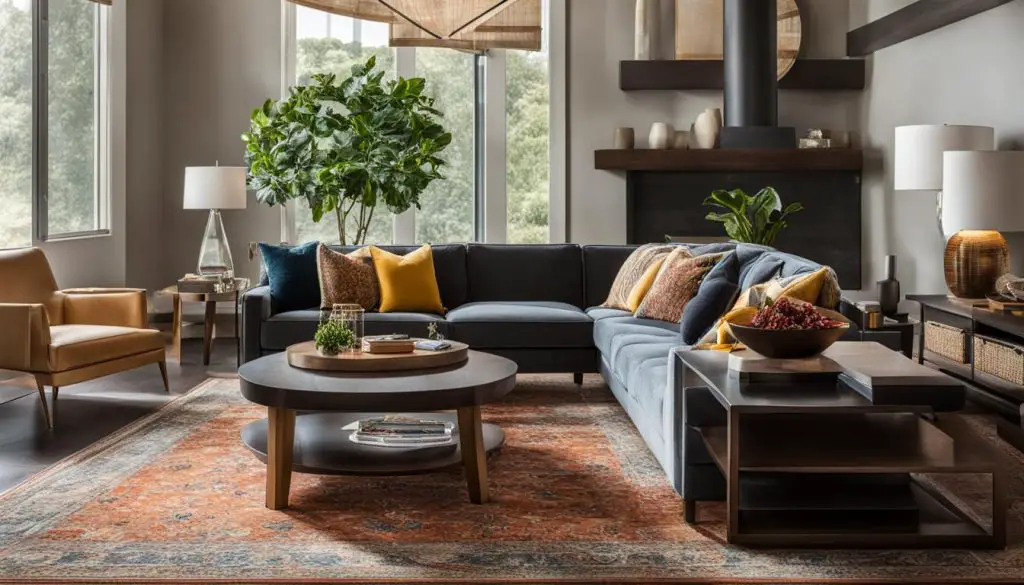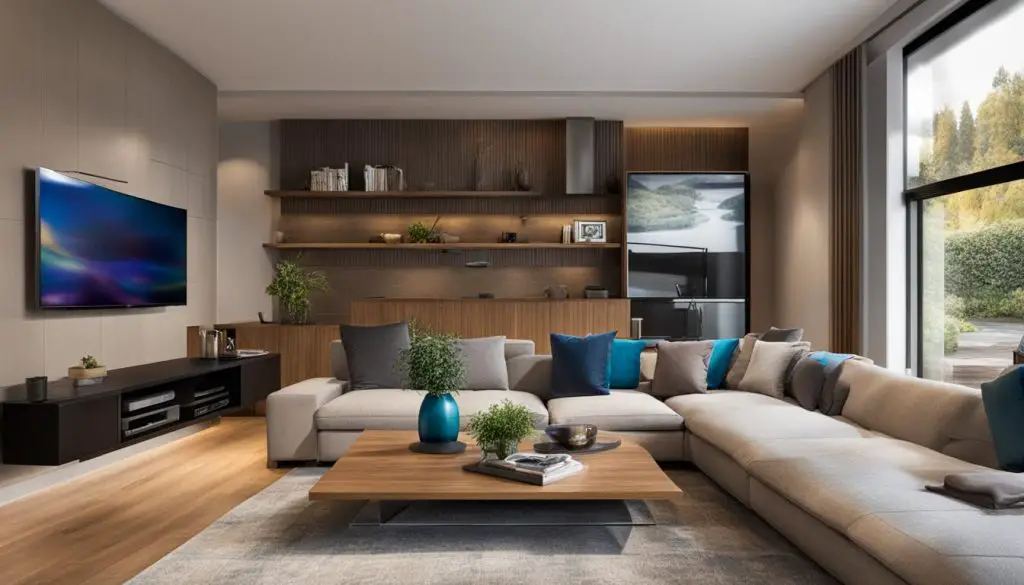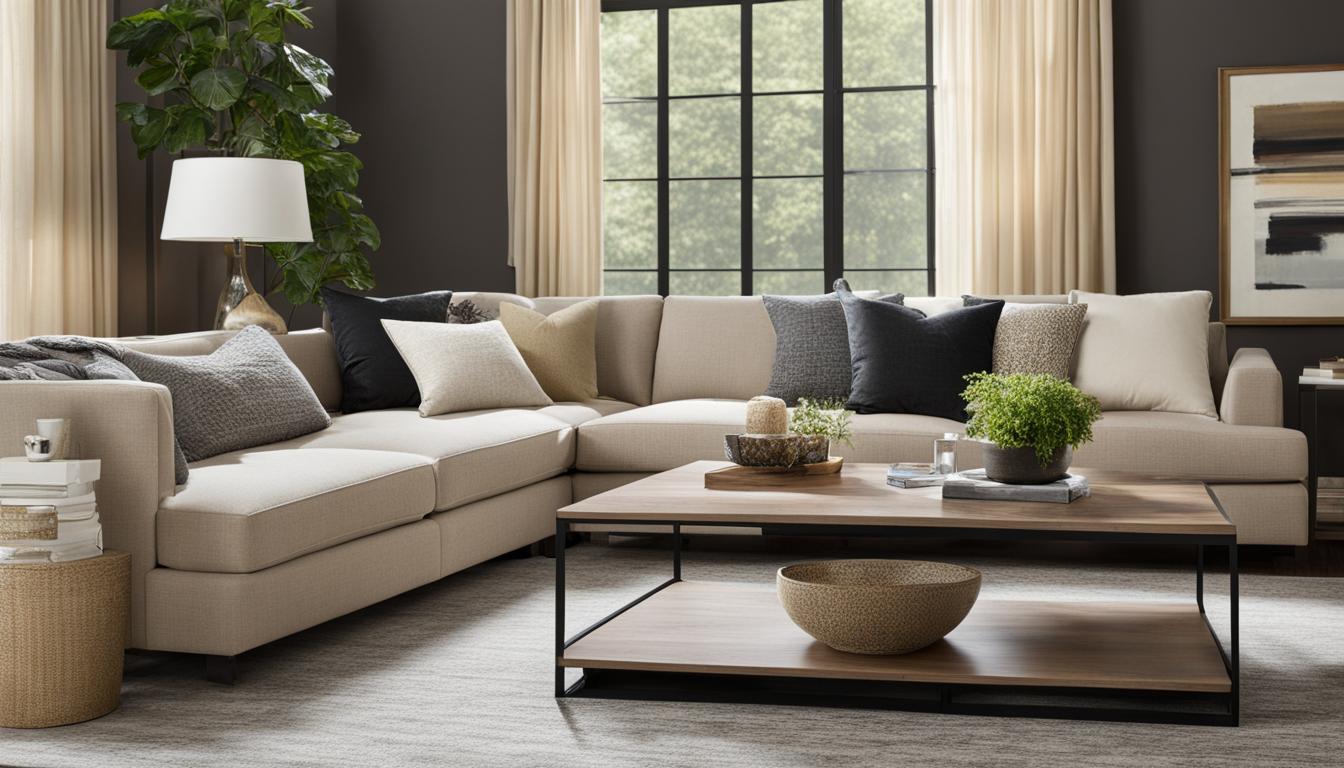Welcome to my blog post on coffee table placement in your living room! If you’ve ever wondered about the ideal distance between your coffee table and couch, you’ve come to the right place. Finding the perfect placement can make a significant difference in the functionality and aesthetics of your space.
According to the general rule of thumb, the coffee table should be placed within about 14 inches to 18 inches from the sofa. This distance allows for easy reach while still providing plenty of legroom. It is recommended to keep the coffee table height close to the seat height of the sofa, within 4 inches in either direction, for easy access. The coffee table should be about ½ to ⅔ the size of the sofa, visually speaking. Side tables can be placed closer to the chair or sofa than the coffee table. The ideal measurement for the distance between side tables and seating is “close enough to set down a drink.” It is also important to consider the height of the side table, which should be no taller than the height of the arm of the chair(s) and no lower than the seat’s height. For chairs without arms, the tabletop should be no more than 8 inches above the seat height.
Key Takeaways:
- Place the coffee table within 14-18 inches from the sofa for easy reach and legroom.
- Keep the coffee table height close to the seat height of the sofa, within 4 inches in either direction.
- The coffee table should be ½ to ⅔ the size of the sofa for visual balance.
- Side tables can be placed closer to the chair or sofa and should be at a height compatible with the chair’s arm or seat.
- The distance between side tables and seating should be “close enough to set down a drink.”
The Placement of Sofa Tables
When it comes to arranging your living room furniture, don’t overlook the importance of sofa tables. These versatile pieces not only add style to your space but also serve as functional surfaces for displaying decor and holding everyday items. But where and how should you place your sofa tables? Let’s dive into the details.
The Height of Sofa Tables
When it comes to the height of sofa tables, it’s essential to consider the overall look and functionality. Sofa tables should be no taller than the height of the sofa back. This ensures that they don’t overpower the sofa and maintain a visually balanced appearance. By keeping the height in proportion, you create a cohesive and aesthetically pleasing look for your living room.
The Size of Sofa Tables
When choosing the size of your sofa table, consider the length of your sofa and the available space. Sofa tables can range from half the length to nearly the full length of the sofa. However, make sure to leave at least 6 inches of space from either end to maintain balance and prevent overcrowding. Choosing the right size ensures that your sofa table complements the sofa and fits harmoniously within the room.
Sofa Table Placement
As for the placement of sofa tables, there are a few options to consider. You can position the sofa table behind the sofa, parallel to the back, creating a seamless look. This placement allows you to display decor or create a functional space for lamps or books. Alternatively, you can place the sofa table against a wall, perpendicular to the sofa. This arrangement adds depth and visual interest to the room. Whichever placement you choose, make sure to leave enough space for easy movement around the table.
| Sofa Table Placement Tips | Benefits |
|---|---|
| Behind the sofa, parallel to the back | – Seamlessly integrates with the sofa – Provides a functional surface for decor and essentials – Adds visual interest to the room |
| Against a wall, perpendicular to the sofa | – Creates depth and dimension – Adds visual interest to the room – Offers additional storage or display space |
Remember, the placement of your sofa tables should complement your overall living room design and enhance the functionality of the space. Take into consideration the height and size of the table, as well as your personal preferences and the available room layout. With careful placement, your sofa table can become a stylish and practical addition to your living room.
Optimal Distance Between Seating
When arranging furniture in your living room, it’s essential to consider the optimal distance between seating to ensure comfort and a cohesive layout. The distance between chairs and sofas can significantly impact the flow and functionality of your space. To create an inviting and intimate atmosphere, it’s recommended to follow specific guidelines when determining the spacing between seating areas.
For conversations and socializing, it’s advisable to have no more than 10 feet and no less than 3 feet between individuals seated around the room. This distance provides a comfortable and intimate setting for interactions. However, when individuals are sharing a sofa or love seat, it’s important to maintain a minimum distance of 3 feet between the people seated on each end to ensure personal space.
Additionally, to avoid a crowded feeling and promote easy movement, there should be approximately 30 inches to 36 inches of walkway between furniture pieces. This allows for seamless navigation and accessibility in the living room. By considering these guidelines, you can create a well-balanced and inviting seating arrangement that fosters conversation and relaxation.
| Furniture Arrangement | Minimum Distance | Maximum Distance |
|---|---|---|
| Individual Seating | 3 feet | 10 feet |
| Shared Sofa/Love Seat | 3 feet | N/A |
| Walkway between Furniture | 30 inches | 36 inches |
Table: Recommended minimum and maximum distances between seating in the living room.
By keeping these recommendations in mind, you can create a well-designed and comfortable living room layout that promotes social interaction and relaxation.
The Size and Placement of Area Rugs
When it comes to creating a stylish and cohesive living room, the size and placement of area rugs play a crucial role. Not only do they add warmth and texture to the space, but they also help define different zones within the room. To ensure you choose the right size and place your area rug correctly, consider the following guidelines.
Choosing the Right Size
The size of your area rug should be determined based on the dimensions of your furniture and the size of the room. As a general rule of thumb, the rug should be large enough to rest under at least two legs of the sofa and chairs in the seating area. This creates a visually pleasing and cohesive look. If your furniture is against the wall, make sure the rug extends past the front legs of all the seating pieces.
Placing the Rug Correctly
Once you have determined the right size, it’s important to place the area rug correctly in the room. The rug should never be closer than 6 inches from the wall to create a balanced and proportional look. In larger rooms, aim to have a distance of around 24 inches between the rug and the wall. In smaller spaces, a distance of 12 to 18 inches works well.
Remember, the placement of an area rug can also help define different areas within the room. For example, you can use a rug to anchor the seating area in an open-concept space or to create a cozy reading nook in a corner. Be mindful of the traffic flow in the room and ensure there is enough space for comfortable movement around the furniture.
| Room Size | Rug Size |
|---|---|
| Small (8′ x 10′ or smaller) | 6′ x 9′ or 8′ x 10′ |
| Medium (10′ x 12′ to 12′ x 15′) | 8′ x 10′ or 9′ x 12′ |
| Large (12′ x 15′ or larger) | 9′ x 12′ or 10′ x 14′ |
By following these guidelines, you can create a well-balanced and beautifully styled living room with the perfect size and placement of area rugs.

The Height and Distance of the TV
When it comes to setting up your living room, finding the right height and distance for your TV is essential for optimal viewing. The height of the TV should be positioned at eye level to minimize strains and ensure a comfortable viewing experience. It is recommended to have the center of the screen about 30 inches above the lowest seat height in the room. This ensures that everyone, whether sitting on a sofa or chair, can easily see the screen without straining their necks.
In terms of distance, it’s important to consider the size and quality of your TV. A general rule of thumb is to place the TV at a distance of about 1.5 times the diagonal measurement of the screen for the average viewer. For example, if you have a 50-inch TV, the optimal viewing distance would be around 75 inches or 6.25 feet. This allows for a comfortable viewing experience and ensures that you can see all the details without feeling overwhelmed or too far away.
Remember, these are just guidelines and can be adjusted based on personal preferences and the layout of your living room. If you have a larger room, you may need to increase the viewing distance slightly. It’s also important to consider the seating arrangement and ensure that everyone has a clear view of the screen without any obstructions.
Table: Recommended TV Height and Distance
| TV Size (inches) | Recommended Height (inches) | Recommended Distance (feet) |
|---|---|---|
| 32 | 21 | 4.5 |
| 40 | 26 | 6 |
| 50 | 31 | 7.5 |
| 55 | 34 | 8.75 |
| 65 | 41 | 10.25 |
By following these guidelines, you can create a comfortable and immersive viewing experience in your living room. Remember to adjust the height and distance based on personal preferences, the size of your TV, and the layout of your space. With the TV positioned at the right height and distance, you can enjoy your favorite shows, movies, and games without any visual discomfort.

The Height of Artwork on the Wall
When it comes to hanging artwork on the wall, the height at which it should be placed plays a crucial role in creating an aesthetically pleasing and balanced look. Generally, the center of the artwork should be at standing eye level, which is around 57 inches from the floor. This ensures that the artwork is easily visible and can be enjoyed by viewers without straining their necks.
In rooms where people predominantly sit, such as living rooms or dining areas, it is recommended to hang the artwork at a seated eye level. This eye level is typically 30 inches above the seat height. By adjusting the height of the artwork to match the seated eye level, it ensures that the artwork is enjoyed at an optimal viewing angle while seated.
When hanging artwork, it is important to leave some space between the edge of the piece and the surrounding elements, such as the ceiling, floor, or adjacent walls. A general guideline is to leave 6 to 12 inches of space, depending on the size of the artwork and the overall dimensions of the room. This space creates a visually balanced composition and allows the artwork to stand out as a focal point in the room.
By considering the height and placement of artwork on the wall, you can enhance the overall visual appeal of your living space. Whether you choose to hang artwork at standing eye level or seated eye level, remember to leave some space around the piece to create a harmonious and balanced display. With thoughtful artwork placement, you can transform your walls into captivating art galleries that reflect your unique style and personality.
Furniture Placement Rules for Living Rooms
When it comes to creating the perfect living room layout, furniture placement plays a crucial role. By following a few simple rules, you can ensure that your living space is both functional and aesthetically pleasing.
Keep a Clear Pathway
One of the most important aspects of furniture placement is to leave enough space for comfortable movement. Ensure that there is at least 2 feet of walkway between large furniture pieces, such as the sofa and the coffee table. This will allow for easy navigation and prevent your living room from feeling cramped and cluttered.
Leave Space from the Walls
A common mistake in furniture placement is pushing all the pieces against the walls. Instead, try leaving at least one inch of space between the backs of furniture, such as sofas and chairs, and the walls. This not only protects your furniture from damage but also creates a more visually appealing and balanced arrangement.
Optimize Rug Placement
A well-placed area rug can tie the whole room together. To ensure that your rug complements your furniture, position it in a way that allows for at least the front legs of the sofa and all chairs to rest on it. This creates a cohesive look and defines the seating area in your living room.
By following these furniture placement rules, you can create a living room layout that is functional, visually appealing, and reflects your personal style. Remember to consider the size and shape of your furniture pieces, as well as the overall dimensions of your space. With careful planning and attention to detail, you can transform your living room into a cozy and inviting retreat.
| Furniture Placement Rules for Living Rooms |
|---|
| Keep a Clear Pathway |
| Leave Space from the Walls |
| Optimize Rug Placement |
Lighting Placement Guidelines
Proper lighting placement is essential for creating a well-lit and inviting living room. By strategically positioning lamps and ceiling lights, you can enhance the ambiance and functionality of your space. Here are some guidelines to consider:
Lamp Height
When it comes to table and floor lamps, the height is crucial. The lampshade should be at eye level when seated to provide optimal lighting for reading or other activities. Ensure that the light source is not directly in your line of sight, as this can cause glare. Experiment with different lamp heights to find the perfect balance between functionality and aesthetics.
Ceiling Light Width
When choosing ceiling lights, consider the width of the fixture in proportion to the size of your room. A general rule of thumb is to select a light that is one-third to one-half the width of the surface it is illuminating. This helps to distribute light evenly and prevents the fixture from overpowering the room. Remember to take into account the height of your ceiling as well, ensuring that the light is hung at an appropriate distance from the floor.
“Proper lighting placement is essential for creating a well-lit and inviting living room.”
By following these lighting placement guidelines, you can transform your living room into a cozy and well-lit space. Experiment with different lamp heights and ceiling light widths to find the perfect combination that suits your style and needs. Remember, lighting plays a significant role in setting the mood and functionality of a room, so take the time to find the right balance of illumination for your living room.
Conclusion
As we conclude our discussion on furniture placement in the living room, it’s important to remember the key guidelines for creating an optimal layout. By following the coffee table spacing guide, considering the distance between seating, choosing the right rug size, positioning the TV correctly, hanging artwork at the right height, and placing lighting fixtures strategically, you can achieve a functional and stylish living room.
Understanding the recommended distance between the coffee table and sofa, as well as the ideal size and placement of side tables, will ensure easy reach and a visually balanced look. Additionally, maintaining an appropriate distance between seating arrangements and leaving enough walkway space will promote comfortable movement and conversation.
Don’t forget to consider the size and placement of area rugs to tie your furniture pieces together and create cohesion. The height and distance of the TV should be optimized for comfortable viewing, while artwork should be hung at eye level. Lastly, proper lighting placement will enhance the ambiance and functionality of your living room.
By taking these furniture placement tips into account and adapting them to your specific space and personal preferences, you can achieve an optimal living room layout that is both inviting and functional. So go ahead, arrange your furniture with confidence and create a living room that reflects your style and enhances your daily living.
FAQ
How far should the coffee table be from the couch?
The coffee table should be placed within about 14 inches to 18 inches from the sofa for easy reach while still providing plenty of legroom.
What is the recommended height for the coffee table?
It is recommended to keep the coffee table height close to the seat height of the sofa, within 4 inches in either direction, for easy access.
How big should the coffee table be compared to the sofa?
The coffee table should be about ½ to ⅔ the size of the sofa, visually speaking.
How far should side tables be from the seating?
Side tables can be placed closer to the chair or sofa than the coffee table. The ideal measurement for the distance between side tables and seating is “close enough to set down a drink.”
What is the ideal height for side tables?
The height of the side table should be no taller than the height of the arm of the chair(s) and no lower than the seat’s height. For chairs without arms, the tabletop should be no more than 8 inches above the seat height.
How tall should sofa tables be?
Sofa tables should be no taller than the height of the sofa back.
What is the recommended size for sofa tables?
Sofa tables can range from half the length to nearly the full length of the sofa, as long as there is at least 6 inches of space from either end.
How should furniture be spaced to optimize intimate conversation?
There should be no more than 10 feet and no less than 3 feet between people seated around the room. The people seated on each end of sharing sofas and love seats should be at least 3 feet apart.
How much walkway space should there be between furniture pieces?
There should be about 30 inches to 36 inches of walkway between furniture pieces to avoid a crowded feeling.
How far should area rugs be from the wall?
Area rugs should never be closer than 6 inches from the wall. In large rooms, the ideal distance is 24 inches from the wall, while in smaller spaces, it should be between 12 and 18 inches.
How should the area rug be positioned under the furniture?
The area rug should be large enough to rest under two legs of the sofa and chairs, providing a cohesive and visually pleasing look.
What is the recommended height for TV placement?
The TV should be positioned at a height that minimizes reflections and ensures a comfortable viewing position. A recommended height is to have the center of the screen 30 inches above the lowest seat height in the room.
How far should the TV be from the seating?
The distance between the TV and seating will vary depending on the size and quality of the TV, but a general rule of thumb is to keep a distance of 1.5 times the diagonal measurement of the screen for the average viewer.
How should artwork be hung on the wall?
Artwork should generally be hung so that the center of the piece is at standing eye level, about 57 inches from the floor. In rooms where people sit most of the time, artwork can be hung at a seated eye level, which is 30 inches above the seat height.
How much space should be left around artwork?
It is recommended to leave 6 to 12 inches of space between the edge of the piece and the ceiling, floor, or wall edge for a visually balanced look.
How should furniture be spaced in the living room?
Furniture in the living room should be spaced to allow for comfortable movement and flow. There should be at least 2 feet of walkway between large furniture pieces, and at least one inch of space between the backs of furniture and the walls to prevent damage.
How far apart should seating furniture face a TV?
When seating furniture faces a TV, it should be positioned seven to eight feet apart for optimal viewing.
How should floor lamps and side table lamps be positioned?
Floor lamps should have shades covering the bulb when sitting down, and the shade height should be at eye level. Side table lamps should also be at eye level when seated.
How much space should be left between a wall sconce and a mirror or piece of art?
There should be 3-6 inches of space between a wall sconce and the edge of a mirror or piece of art.
How should ceiling lights be hung?
Ceiling lights should be hung between 60-80 inches above the floor, depending on ceiling height, and the width of the light should be proportional to the room size.


